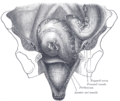Sigmoid colon: Difference between revisions
CSV import Tags: mobile edit mobile web edit |
CSV import |
||
| Line 30: | Line 30: | ||
* Gray, Henry (1918). ''Anatomy of the Human Body''. Lea & Febiger. p. 1182. | * Gray, Henry (1918). ''Anatomy of the Human Body''. Lea & Febiger. p. 1182. | ||
{{dictionary-stub1}} | {{dictionary-stub1}} | ||
== Sigmoid_colon == | |||
<gallery> | |||
File:ColonSigmoideo.png|Colon Sigmoideo | |||
File:Gray1223.png|Gray 1223 | |||
File:Dickdarm-Schema.svg|Dickdarm Schema | |||
File:Gray1076.png|Gray 1076 | |||
File:WeiblichesBeckenMedian.gif|Weibliches Becken Median | |||
</gallery> | |||
Latest revision as of 20:55, 23 February 2025
Sigmoid colon is the part of the large intestine that is closest to the rectum and anus. It forms a loop that averages about 40 cm in length, and normally lies within the pelvis, but on account of its freedom of movement it is liable to be displaced into the abdominal cavity.
Structure[edit]
The sigmoid colon begins in the pelvic cavity, continuing from the descending colon. It ends at the rectum. It is completely surrounded by peritoneum (the sigmoid mesocolon), which is attached to the pelvic wall by a duplication of peritoneum known as the sigmoid mesocolon.
Function[edit]
The main function of the sigmoid colon is to store fecal wastes until they are ready to be eliminated from the body. It also absorbs water and electrolytes.
Clinical significance[edit]
The sigmoid colon can be subject to several diseases, including diverticulitis and cancer. It can be removed by surgery, in a procedure known as a colectomy.
See also[edit]
|
|
|
References[edit]
<references />
External links[edit]
Further reading[edit]
- Moore, Keith L.; Dalley, Arthur F.; Agur, Anne M. R. (2013). Clinically Oriented Anatomy. p. 215. ISBN 978-1-4511-1945-9.
- Gray, Henry (1918). Anatomy of the Human Body. Lea & Febiger. p. 1182.
Sigmoid_colon[edit]
-
Colon Sigmoideo
-
Gray 1223
-
Dickdarm Schema
-
Gray 1076
-
Weibliches Becken Median








